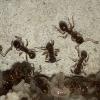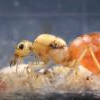Sorry if I sound agitated, but I've been dealing with this problem for awhile and had no luck solving it. Basically, the majority of my test tube setups fail in one of three ways:
1. The biggest cause is just the tubes getting moldy. No matter how well I clean the tubes beforehand, they always seem to start growing mold within a couple weeks, and are totally covered in as little a month or two. I'd say this problem alone has wiped out half of my queens/small colonies. They never seem to want to move into a different test tube, and if I force them, they usually freak out and either eat their brood or stop producing it at all. I'm not sure what I'm doing wrong here. Maybe I just have to sterilize my test tubes, cotton balls, and water super well?
2. A few hours or days after making the setup, a small amount of water will leak through the cotton and onto the floor of the tube. Obviously, the queens really don't like that. I tried simply not pushing the cotton ball down as far, but it still occasionally happens. I end up needing to, again, move the queen to a new setup, which they really don't like.
3. The ants refuse to actually search for food. Once the first workers arrive, you need to start feeding them. I know you can place a small amount of food inside the tube, but I don't like to do this because it both makes the cotton mold way faster and it's very easy to get escapees. I've tried both putting the tube into a small takeout container and putting the food nearby the open end of the tube, along side 3D printing a small room with a removable cover that fits on the end of the tube. They usually either end up not ever leaving the tube, or moving OUT of the tube and into the small room, which defeats the whole purpose.
What would you guys recommend I do to either prevent these problems, or deal with them when they occur? An idea I had with the mold is to put a small drop of food-grade hydrogen peroxide into the water before adding the cotton, and then shining an ultraviolet light onto it for awhile. The H2O2 + UV light combo is one of the best ways to sterilize water, and because the UV breaks down the H2O2, I should be left with just oxygen gas and some ozone, which I'll let sit for a few days to dissipate before putting any living thing inside of it.



















